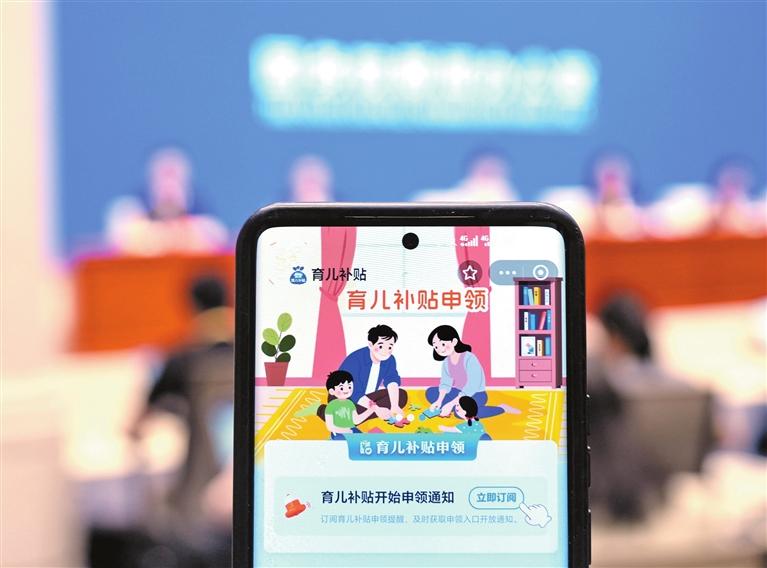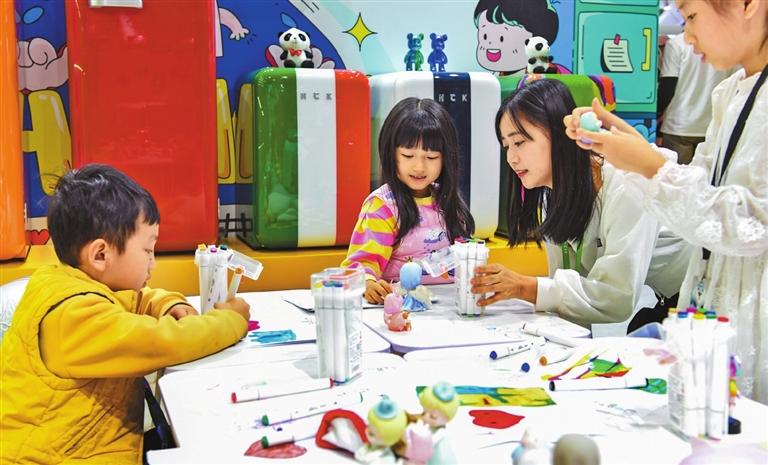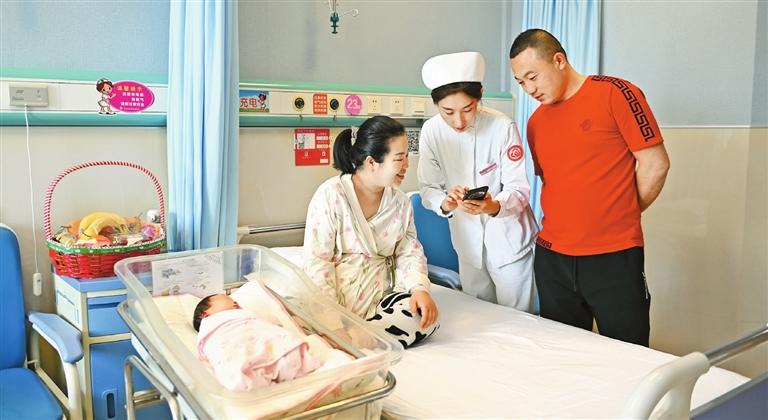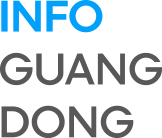"Yes! I just received a text message a couple of days ago saying my application [for the national childcare subsidy] has been approved," Zhong Yiqing, the mother of a newborn in Nanshan District, said excitedly Oct. 8. She added that her family has not received the bank transfer yet.
National childcare subsidy program
Zhong gave birth to her first child in December of last year, just in time to qualify for China's first-ever large-scale, universal cash assistance program aimed at supporting families and encouraging childbirth.

The interface of the WeChat mini-program for the childcare subsidy application.
On July 28, the Central Government announced the introduction of the childcare subsidy program, which came into effect on January 1, 2025. It offers a monthly payment of 300 yuan (US$42.11) per child for those under 3 years old. The total of the subsidy for children born in January 2025 and after is 10,800 yuan over a three-year period. Children born before Jan. 1, 2025 are also eligible, and their parents will receive payments calculated from January 2025 until they reach age 3.
The initiative was introduced to address the two demographic challenges the nation faces. China, one of the most populous countries in the world, is simultaneously experiencing a declining birth rate and a rapidly aging population.
The country's birth rate and total number of newborns declined for seven consecutive years before showing a modest rebound in 2024, the Year of the Dragon, a symbol many Chinese people regard as auspicious. Meanwhile, the population aged 60 and above had reached 310 million by the end of last year.
Although Shenzhen's birth rate led the country at 19.07 per 1,000 between 2010 and 2020, the city witnessed a sharp decline in the following years, with rates of 15.09 per 1,000 in 2021, 9.23 per 1,000 in 2022, and a further drop to 8.46 per 1,000 in 2023, according to the Shenzhen Statistical Yearbook. The 2024 figure is not yet available.

A teacher interacts with children at a child-friendly expo in Shenzhen in this file photo.
The reasons behind the continued decline in birth rates are complex, but connected to the dilemma of balancing a family with a career as well as a broader social shift toward individualism. The primary deterrent is economic — high housing prices, soaring education costs, and increasing medical expenses — leading many childbearing-aged couples to think twice about having a child.
According to a Xinhua report last month, more than 20 million families nationwide will benefit from the program each year.
New initiative earns praise
The national program began accepting applications nationwide in late August of this year, while in Shenzhen, eligible parents could start applying Sept. 8.
Zhong, who works at an art training center in Nanshan's Houhai area, filed her application immediately after learning about it in a WeChat group for newborn mothers. She gets much of her information from the chat group, where mothers share practical tips and updates.
"I remember the group was filled with heated discussion about when the subsidy program would be implemented and how it would help families financially," Zhong recalled.
Following instructions on the WeChat mini-program, she uploaded a copy of her ID, her bankcard, and her child's birth certificate. "It didn't take me long to complete the entire application online — about 15 minutes," said the mother of a 10-month-old baby. "That's it. Then we just need to wait for our application to be reviewed and approved," she added.
Zhong admitted that 300 yuan a month isn't that much considering the high living costs in a major city like Shenzhen. "It's probably only enough to cover our daughter's monthly diaper expense, but it's a nice gesture," she said. "I also see it as a signal that the government will continue to roll out successive incentive measures to encourage childbearing."
Although official figures on the number of childcare subsidy applications in Shenzhen are not yet available, many eligible families have applied for it, including many of the mothers in Zhong's chat group.
Wang Minmin and her husband, whose second child was born in October 2024, submitted their application via Alipay after the National Day holiday. "My family is still waiting for approval after submitting all required materials online. The process was fairly easy," she said.
Mao Jinyan, a mother of two sons who lives in Bao'an District, said she and many mothers she knows have submitted their applications. "I applied in person at the subdistrict office," she said, adding that the process is straightforward.
Easy to apply
Taking advantage of the city's strong digital government services, Shenzhen has established an easy-to-use application network that combines online and in-person channels to meet diverse applicant needs.
Multiple online access points have been opened, enabling residents to apply directly through the national unified system, the Guangdong Provincial Government service platforms, or the "childcare subsidy" mini-programs on WeChat and Alipay.
At hospitals and medical institutions across the city, dedicated staff have been assigned to guide new mothers on how to scan an application QR code to register their newborn's birth information, which is then automatically verified.
In-person services are equally convenient. Citywide, subdistrict offices have opened exclusive service windows to handle applications, with on-site guidance for those who are not familiar with online procedures or have limited internet access.
These "one-visit-for-all" streamlined services are powered by citywide data sharing among various government departments, integrating information from health, public security, and medical insurance authorities.

A nurse helps new parents apply for the childcare subsidy at a hospital in Hohhot, Inner Mongolia. Photos from Xinhua
SZ's boost to the national policy
As Zhong noted, the annual national subsidy of 3,600 yuan offers limited financial help for families in Shenzhen, a tier-one city where the cost of living is considerably higher than in other cities. According to a 2021 report on the cost of raising infants and toddlers (age 0-3), the average cost of raising a child from birth through age 3 in Shenzhen is 74,612 yuan—well above the national average.
To ease the burden, Shenzhen has drawn up a complementary package to provide extra financial support to local families. Under the plan, which is currently open for public consultation, local families with Shenzhen hukou and those with only one parent being a permanent resident in Shenzhen will qualify—a move that will widely expand eligibility, considering that about 60% of the city's population of 17 million are non-hukou residents.
According to the plan, for the first child, Shenzhen would provide a one-off stipend of 3,000 yuan plus an additional 1,500 yuan a year for three years. For a second child, the one-off stipend would be 5,000 yuan plus an extra 2,000 yuan a year for three years. For a third child, the one-off would be 10,000 yuan with 3,000 yuan annually for three years.
Based on the national subsidy of 3,600 yuan a year, the combined cash assistance under the current proposal would total about 18,300 yuan for a first child from birth through age 3, 21,800 yuan for a second child, and 29,800 yuan for a third child (figures subject to final approval).
As a migrant city, Shenzhen makes its local subsidy scheme relatively accessible by requiring only one parent in the household to hold Shenzhen residency to apply. Based on official figures from 2023, more than 300,000 babies and toddlers would be eligible for the city's cash assistance, costing municipal coffers 974 million yuan.
"That would be good news when Shenzhen starts implementing the local childcare subsidy," said Wang Minmin, a resident of Futian District who had not heard about the city's subsidy plan until recently.
Wang, a mother of two, said that the government support—the local subsidy (rounded up to 3,700 yuan a year for a second child) combined with the national 3,600-yuan annual payment—will help her family cover her younger daughter's early-education expenses until she reaches age 3, at which point she will enter kindergarten.
Further childcare incentives
When Wang's younger daughter is old enough for kindergarten, her family will be entitled to an annual subsidy of 1,500 yuan for every kindergarten-aged child, which is seamlessly connected to the childcare grant program. Of the 1,500 yuan, 1,300 yuan is allocated to kindergarten fees, while the remaining 200 yuan covers other expenses such as health checkups and education supplies, such as picture books and cognitive development teaching aids. The policy became effective in the fall of 2012.
Starting in the fall semester of 2025, China will waive care and education fees nationwide for children in their final year of public kindergarten. In China, kindergarten is a three-year program for children typically aged three to six. The policy is expected to cover 12 million children nationwide. For those attending private kindergartens, care and education fees equivalent to those charged at public kindergartens will also be waived. The costs will be subsidized jointly by the Central and local governments.
Shenzhen goes further, providing an additional 7,000 yuan per year for each primary school student and up to 9,000 yuan per year for each junior high school student studying at government-commissioned private schools. The policy covers children with Shenzhen hukou, as well as non-hukou children who have at least one parent who holds permanent residency in Shenzhen and has contributed to the city's social security program for at least one year.
"This is a smart investment in both children and the economy," Amakobe Sande, representative of the United Nations Children's Fund (UNICEF) to China, said when commenting on the national childcare subsidy program.
"A cash transfer, rather than a tax credit, will better support the most vulnerable families," she said. "Making it universally available to children in both urban and rural areas will help close regional gaps in child support, and ring-fencing a central budget to cover the costs of this investment will ensure sustainability."
As a pilot city in the national effort to build child-friendly cities, Shenzhen has developed a full-chain support system covering childbirth, childrearing, and education. Wang said, "The subsidy is not just money. It shows the city's care for families with children, giving parents the confidence to have children, raise them, and raise them well."
Regardless of whether the government adopts additional support for families with two or more children, Zhong said she still plans to have a second child, perhaps in a few years. "I'd like my child to grow up with a sibling."






